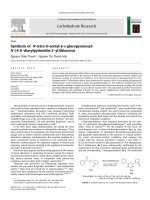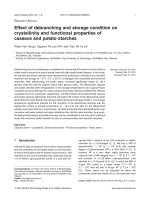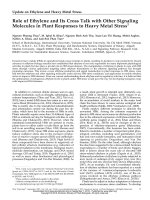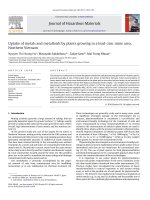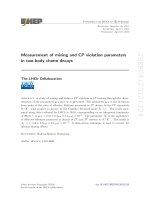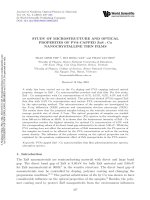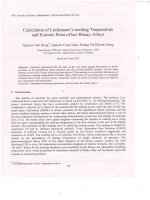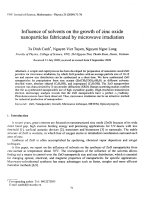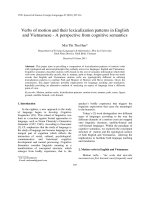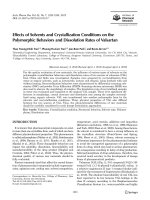DSpace at VNU: Influence of dry operating conditions: observation of oscillations and low temperature CO oxidation over Co30 4 and Au Co304 catalysts
Bạn đang xem bản rút gọn của tài liệu. Xem và tải ngay bản đầy đủ của tài liệu tại đây (453.9 KB, 8 trang )
Catalysis Letters 25 (1994)257-264
257
Influence of dry operating conditions: observation of
oscillations and low temperature CO oxidation over
Co30 4 and Au/Co304 catalysts
D.A.H. Cunningham 1, T. Kobayashi, N. Kamijo and M. Haruta
Osaka NationalResearch Institute, AIST, Midorigaoka 1-8-31, lkeda 563, Japan
Received21 May 1993;accepted 12January 1994
The effect of dry operating conditions upon the oxidation of CO over Co304 and
Au/Co304 has been studied. Under dry conditions (with pretreatment and reaction gases dried
at -76~ using molecular sievetraps) oxidation of CO over Co304 can be observedat temperatures as low as -54~ However, without sufficientdrying Co304 rapidly deactivates. On the
other hand, the Au/Co304 catalyst is resistant to the presenceof moisture even at low temperatures. For both the Co304 and Au/Co304 catalytic systems, strong and periodic oscillations
in percentage conversionand catalyst bed temperature have been observed.
Keywords: Co304; gold;CO oxidation; oscillation;moisture effect
1. I n t r o d u c t i o n
Of the catalytic systems which we have looked at previously for low temperature
CO oxidation, the most active are gold supported upon 3d transition metal oxides
and the hydroxides of alkaline earths [1-5]. Of these, the Co304 and Fe203 systems
are the most promising and high percentage conversions have been obtained even
at dry-ice temperatures.
Mechanistic studies on these supported gold catalysts have recently been
reported by us [5] and interest by other groups on supported gold catalysts is also
growing [6--11]. It has been found, that in addition to the low temperature activity
shown by supported gold, these catalysts also have the advantageous feature of
enhanced activity in the presence of moisture [12]. This is of particular importance
for the removal of CO from air under ambient conditions.
In the study of catalysis, however, the role played by water molecules is still
unclear. T h o u g h the A u / m e t a l oxide system is known to be resistant to water in
simple oxides it appreciably deactivates [13]. It has therefore been suggested that
1 To whomcorrespondenceshould be addressed.
9 J.C. Baltzer AG, SciencePublishers
258
D.A.tl. Cunningham et al. / Influence of extreme dry operating conditions
moisture preferentially adsorbs onto active sites at the metal oxide surface, but as
yet direct evidence supporting this hypothesis has not been reported.
It was therefore of interest that, for the Co304 metal oxide, moisture desorption
occurs over four distinct temperature regions. The first of these regions starts
between 30 and 180~ [14,15] and under normal operating conditions containing
around 3 ppm H20, is comparable with the region where the cobalt oxide starts to
exhibit high activity.
In this paper we present our initial findings on the behaviour of the Co304 catalytic system to the low temperature oxidation reaction of carbon monoxide under
dried, normal and wet conditions. Comparison with Au/Co304 under similar
conditions is also presented.
2. Experimental
Tricobalt tetraoxide was prepared by a 400~ calcination of the carbonate precipitated from an aqueous solution of Co(NO3)2. The crystalline nature was confirmed using X-ray diffraction and a BET analysis revealed a specific surface area
of 52.1 m2/g. Catalysts with small gold particles of diameters less than 5 nm were
deposited on Co3O4 by coprecipitation [1]. For the present studies a 5 at% Au loading has been used with the loading calculated on a Au/(Au + Co) metal basis. The
surface area for the Au/Co304 system was 52.8 mZ/g.
To determine the catalytic behaviour, a fixed-bed reactor shown in fig. 1 was
used. The design of this reactor is identical to that used in earlier studies and is able
to provide both good temperature stability and reproducibility. In this set-up the
mean temperature is measured using a chromel-alumel thermocouple enveloped in
glass and set 1 mm into the catalyst bed. Control at low temperatures (+0.3~
was achieved by methanol/dry ice mixtures. For higher than room temperatures a
standard resistive heater, linked to a computer was used.
Between particles of Co304 and Au/Co304 there is an apparent difference in
packing density. Therefore, to retain the same catalyst bed length we used two different masses of 150 and 300 mg, respectively. For comparison we have also studied each catalyst twice at 10 000 and 20 000 h -1 ml/g-cat space velocities. For both
samples the size distribution was within 70-120 mesh.
In the measurement of percentage conversion, a standard reaction gas containing 1% CO and 99% air was used. In all cases pretreatment was for 40 min at 200~
under air. The catalyst was returned to room temperature while still under air and
the reaction gas then allowed to enter the cell. Analysis of the effluent gas, for CO
and CO2, was made by gas chromatography, using molecular sieve and active carbon columns. Percentage conversion was recorded after holding the temperature
steady for between 30 and 45 min.
For reaction conditions described as wet or normal, the pretreatment step was
carried out without consideration of the moisture level. Under these conditions, the
D.A.H. Cunningham et al. / Influence of extreme dry operating conditions
259
1%C0 in a i r
~-Exhaust
gas
~
Catalyst
Quartz wool
Fig. 1. Diagram of reaction cell used in these studies. Catalyst bed length 3 cm long with the
temperaturerecorded 1 mm into the bed.
moisture entering the reaction vessel during pretreatment was high and typically
well in excess of 10 ppm. The reaction gas used for wet conditions was additionally
bubbled through a water bed to give a moisture level of 6000 ppm. For normal conditions the reaction gas was taken directly from the cylinder without treatment
and contained 3 ppm H20.
For dried conditions both the pretreatment and reaction gases were passed
through molecular sieve traps cooled at dry ice temperatures. Pretreatment and
reaction gases were dried individually and the reaction lines purged thoroughly.
This required between 2 and 4 h after which the moisture level was typically measured at 850 ppb. An additional 2 to 3 h was also required to obtain a stable GC
response due to the retardation effect experienced by the CO as it passes through
the molecular sieve H20 trap.
All moisture levels given above are for the gas directly before entering the reaction vessel. Detection of moisture from between 0.5 and 10 000 ppb was made using
a modified Hycosmo C1202LA cryogenic optical dew point moisture sensor supplied by Osaka Sanso Kogyo Ltd.
3. R e s u l t s a n d d i s c u s s i o n
The data for wet, normal and dried reaction conditions are presented in fig. 2
as a function of temperature. In all cases the data is shown after pretreatment. The
reaction gas was then allowed to enter the reaction cell and the percentage conver-
260
D.A. tt. Cunningham et al. / Influence of extreme dry operating conditions
100
80
0
60
I
normal
I
I
r~
I'J) /)
I
:>
40
0
zo
0
-100
l
1
-60
I
-20
P
20
I
60
I
100
140
Temperature/~
Fig. 2. Conversionprofilesfor CO oxidationoverCo304,withchangesin pretreatmentand reaction
conditions. Data shownis for (t2) wet, (A) normal and (O) dry reaction conditions.Data for
Au/Co304undernormalconditions(x) is shownherefor comparison.
sion recorded at room temperature. The temperature was then increased, or
decreased, depending upon the initial percentage conversion. In this diagram, the
data for Au/Co304 under normal reaction conditions is shown for comparison.
Looking first at the difference between Co304 under normal and wet conditions, two curves are obtained separated by some 40~ When the reaction conditions were changed to dry pretreatment and reaction gases this shift continues and
the operating temperature for 50% conversion decreases to -54~ At this point
deactivation of the catalyst is rapid with the percentage conversion decreasing
from 100 to 35%. For Au/Co304 under normal reaction conditions a sharp drop in
conversion was only observed near - 76~
To test the reproducibility of this deactivation temperature, the operating temperature was reduced from room temperature over cooling times ranging three to
seven hours (fig. 3). In each case different samples were additionally used, however,
between each of the plots the difference in deactivation temperature is only 1.5~
To reduce the operating temperature below -54~ for Co304, it was found
necessary to rapidly cool the system at much higher rates. This can be done, for
example, by the direct cooling of the catalyst in dry ice methanol. This is shown in
fig. 4 where the percentage conversion for both Au/Co304 and Co304 catalysts are
presented directly from the point of immersion. In this figure, percentage conversions have been obtained under dry conditions at two space velocities (10 000 and
20 000 h-1 ml/g-cat) and within 20 min ofpretreatment.
Considering first only the Au/Co304 catalyst, the time observed for deactivation (around 100 min) compares favorably with data which we have already published [16]. In this diagram we have defined the deactivation time as being only the
time required for the conversion to fails below 100%. This is generally easier to
define than the time required to reach steady-state.
D.A.H. Cunninghamet al. / Influenceof extreme dry operating conditions
261
100
80
60
O
40
o
20
0
-I
--7'0 -6'0 -s'o -4'0 -3~0 -2'0 -1'0
Temperature/~
Fig. 3. Reproducibility of low temperature behaviour for 150 mg CoaO4, under dry operating conditions, with catalyst cooled slowly over periods ranging from 3 to 7 h.
By decreasing the space velocity by half, from 20 000 to 10 000 h -1 ml/g-cat,
the time from immersion to loss of 100% conversion increases from 45 to around
100 min (a factor of 2.2). The Co304 metal oxide catalyst, identified by black and
clear circles, shows similar behaviour to that of Au/Co304 and between the two
flow-rates the difference in deactivation time is comparable at 2.3.
From these time ratios the difference between Au/Co304and Co304 therefore
appears quite small. However, as can be clearly seen in the times required before
visible deactivation of the catalyst takes place, there is an apparent contradiction in
the results. In all studies which we have so far carried out, we found consistently
that the time required for deactivation was always less for Au/Co304 than for
100 ........
i
80
00 h'l,ml/g-cat
0
60
.,.,-i
r
40
o
~.~
20
g cat
0
100
200
300
4(t0
500
Time/minutes
Fig. 4. Conversion profiles, as a function of time, for CO oxidation operated at -76~ under dry conditions. Data is shown for 300 mg Au/Co304 ( 0 and O) and 150 mg Co304 (O and O). In each
case black symbols represent a space-velocity of 10000h -l ml/g-cat and open symbols
20 000 h -1 ml/g-cat.
262
D.A.H. Cunningham et aL / Influence of extreme dry operating conditions
a)
-69
i O 0 ~I..............h,.h,,,,,,,,..,,, I
t
80
.
~
-70 rD
o
-71
Percentage
~ ~ ~./converslon
60
-72 ~
4O
-73 ~
&O
>
o
L~
-74 I~
20
9_75 ,'F~
0
0
I0'0 20'0 30'0 40'0
500
Time/minutes
-76
b)
lO0.z ..................t..................~.......... ,
I
80
t
-65
Percentag e
sonversion
- 67
o .60
~0
> 40
~wAr~
0
Te m p e r a ~
100
200
300
-73 ~
400
500
Time/minutes
Fig. 5. Oscillations in (A) temperature and ([2) percentage conversion for (a) 150 mg of Co304 at
10000 and (b) 300 mg of Au/Co304 at 5 000 h -1 ml/g-cat space velocities. In Au/CoaO4 a reduced
space velocity is used to show the decrease in oscillation frequency.
Co304. Additionally, when the Au/Co304 catalyst was cooled slowly, we failed to
observe any signs of deactivation at temperatures near -54~ For these studies
the longest cooling cycle attempted was between 6 and 7 h.
The observation that CO304 deactivates at higher temperatures than
Au/C0304, but takes longer to show signs of deactivation when directly immersed
in a dry ice/methanol bath appears difficult to explain. The decrease in conversion
of CO, over Co304, when the temperature was gradually decreased from room temperature, may be ascribed to a slow accumulation of water molecules at the surface
and that this accumulation does not cause deactivation in Au/C0304. However,
such an explanation does not readily explain the absence of time dependency in
studies where the cooling rate was varied between 3 and 7 h.
In experiments carried out at dry ice temperature (-76~
with the catalyst
directly immersed soon after pretreatment, we consider that the decrease in percentage conversion may be caused mainly by the accumulation of carbonate intermedi-
D.A.H. Cunningham et al. / Influence of extreme dry operating conditions
263
ates on the surface. Since the total exposed area of metal oxide in the Au/Co304
system is less than for Co304 the time required to deactivate the surface by these
carbonate intermediates should decrease. The decomposition of these carbonate
species is also considered to be the rate determining step in the oxidation of CO at
low temperatures [5].
A second feature of interest in these diagrams is the presence of periodic oscillations in the percentage conversion seen at low temperatures. These oscillations
appear in the region where the percentage conversion is lower than 40% and therefore where heat transfer problems are usually considered to be less serious. Oscillations can also be seen in the catalyst bed temperature, fig. 5, and extend into the
100% conversion region.
Oscillations in the signal intensity and temperature of the catalyst bed may be
explained by a number of models. We, however, believe that the most probable
explanation is the intermittent decomposition of carbonate intermediates at the
catalyst surface. Other models under consideration related to the Pt-based system
[17-22], which explain oscillations either through changes in surface morphology
or by coupled heat and mass transfer limitations. Further work is now required to
determine the cause and to determine how the process occurs in the absence of a
noble metal.
4. Conclusions
In summary, we would like to emphasize three main points from this work.
Firstly, in agreement with previous observations we have determined Au/CoaO4
is not appreciably influencedby the presence of moisture. Further work is required,
but it is considered that the contact region between gold and metal oxide is the most
probable adsorption and reaction site. At this site the CO is then able to interact
with the metal oxide (in the presence of moisture) by using the Au particle as a pathway to the surface.
Secondly, without the use of gold and by drying the pretreatment and reaction
gases, CO oxidation is observed over the Co304metal oxide at temperatures as low
as -54~ The higher temperature range of 30-58~ under normal conditions, is
believed to be a consequence of a simple competition between moisture and CO
molecules for the same adsorption sites upon the Co304 surface. Sufficient drying
of the catalyst therefore allows a number of these sites to become available for the
adsorption of carbon monoxide, allowing oxidation to then take place. The
increase of the temperature for 50% conversion to 93~ under wet conditions is in
agreement with this model.
Thirdly, under dried conditions we have observed, at temperatures as low as
-76~ a number of sharp oscillations in plots of both the percentage conversion
and the catalyst bed temperature.
264
D.A. 1t. Cunningham et al. / Influence of extreme dry operating conditions
Acknowledgement
We would like to acknowledge the financial and scientific support from the
Science and Technology Agency of Japan during this work.
References
[1] M. Haruta, N. Yamada, T. Kobayashi and S. Iijima, J. Catal. 115 (1989) 301.
[2] S. Tsubota, M. Haruta, T. Kobayashi, A. Ueda and Y. Nakahara, in: Preparation of
Catalysts V, eds. G. Poncelet, P.A. Jacobs, P. Grange and B. Delmon (Elsevier, Amsterdam,
1991) p. 695.
[3] M. Haruta, K. Saika, T. Kobayashi, S. Tsubota and Y. Nakahara, Chem. Express 3
(1988) 159.
[4] S. Tsubota, N. Yamada, M. Haruta, T. Kobayashi and Y. Nakahara, Chem. Express 5
(1990) 349.
[5] M. Haruta, S. Tsubota, T. Kobayashi, H. Kageyame, M.J. Genet and B. Delmon, J. Catal. 144
(1993) 175.
[6] S.D. Gardner, G.B. Hoflund, B.T. Upchurch, D.R. Schryer, D.R. Kielin and J. Schryer,
J. Catal. 129(1991) 114.
[7] S. Takamatsu, M. Ishii, M. Imagawa, H. Kinbara, T. Kikuta and T. Fukushima, Shokubai
(Catalyst) 34 (1992) 126.
[8] S.K. Tanielyan and R.L. Augustine, Appl. Catal. A 85 (1992) 73.
[9] A. Knell, P. Barnickel, A. Baiker and A. Wokaun, J. Catal. 137 (1992) 306.
[10] C. Sze, E. Gulari and B.G. Demczyk, in: Nanophase andNanocomposite Materials, Mater. Res.
Soc. Proc., Vol. 286 (1992) 145.
[11] S.D. Lin, M. Bollinger and M.A. Varmice, Catal. Lett. 17 (1993) 245.
[12] M. Haruta, T. Takase, T. Kobayashi and S. Tsubota, in: Catal. Sci. Techn., Vol. 1, eds.
S. Yoshida, N. Takezawa and T. Ono (Kodansha, Tokyo, 1991) p. 331.
[13] A. Lopez, J.M. Palacios and J.L.G. Fierro, Appl. Catal. A 91 (1992) 43.
[14] Y. Takita, T. Tashiro, Y. Saito and F. Hori, J. Catal. 97 (1986) 25.
[15] Y.Y. Yao, J. Catal. 33 (1974) 108.
[16] M. Haruta, T. Kobayashi, H. Sano and N. Yamada, Chem. Lett. (1987) 405.
[17] G. Ertl, P.R. Norton and J. Rustig, Phys. Rev. Lett. 49 (1982) 177.
[18] K. Krischer, M. Eiswirth and G. Ertl, J. Chem. Phys. 96 (1992) 9161.
[19] P. Heilmann, K. Heinz and K. Muller, Surf. Sci. 83 (1979) 487.
[20] M. Sander, R. Imbihl, R. Schuster, J.V. Barth and G. Ertl, Surf. Sci. 271 (1992) 159.
[21] P.R. Norton, P.E. Binder, K. Griffiths, T.E. Jackman, J.A. Davies and J. Rustig, J. Chem.
Phys. 80 (1984) 3859.
[22] H.U. Onken and E.E. Wolf, Chem. Eng. Sci. 47 (1992) 1659.
